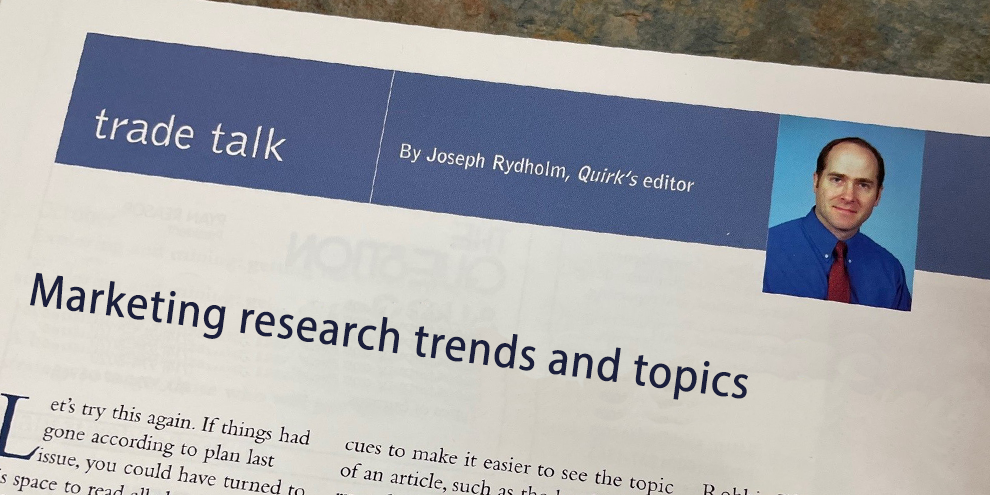This being the health care research issue, I read with interest some press material on societal health trends sent to me by the folks at the Natural Marketing Institute (NMI), a Harleysville, Pa., consulting and research firm.
Drawing from various NMI research sources - including the Health & Wellness Trends Database, the LOHAS (Lifestyles of Health and Sustainability) Consumer Trends Database, the Evolution of Personal Care Database, Healthy Aging/Boomer Database and Immerzions - NMI annually releases a list of movements in the health and wellness sphere.
As taken from the company’s press materials, for each of the trends, NMI sees evidence of a countertrend. For example, within NMI’s health and wellness segments of the U.S. population, there are two groups, the Well Beings and the Eat, Drink & Be Merrys. Each represent approximately 25 percent of the population yet they exhibit opposite attitudes and behaviors toward health and wellness. The Well Beings are an integrated and healthy group comprised of values-based consumers. Their polar opposite is the Eat, Drink & Be Merrys, who are the least-concerned, least-health active and least-involved consumers.
NMI feels that the concept of a unified America has given way to bifurcation across many aspects of society including income, education, religious values, the environment, politics and even a stratification across health behaviors and attitudes, as the healthiest and the least healthy segments continue to diverge.
Countering that movement is the impact of technology, which, thanks to the rise of online social and business networks, functions as a societal equalizer and unifier. A desire for unification and connectivity appears to be at the core of this movement, manifesting itself in the popularity of sites like Facebook, LinkedIn, the Family Post and Ancestry.com.
Other trends:
- Generation Z(zzzz)
Those in Generation Z are an overstimulated and burned-out lot. Aged 25-45, they are getting less than seven hours of sleep per night and, as a result, are surviving on caffeine-packed energy drinks and sleeping pills. The health implications of this behavior are just becoming known and include an increase in domestic violence, traffic accidents, obesity and stress, NMI says. In contrast to Generation Z are those seeking sleep alternatives through alternative medicine, meditation, a reduced schedule and a simplified lifestyle.
- Stop, I want off!
The overabundance of technology, busier lifestyles, dual working families and instant gratification is driving many to opt out of the current consumer culture. From scaling back work hours to a renewed focus on quality versus quantity and even a rejection of technology, the consumer backlash reflects a growing recognition of the true price we as a society pay for such lifestyles.
While many are rejecting conspicuous consumption, the other end of the spectrum continues to embrace luxury, premiumization and 24/7 connectivity.
- Dr. Me
Those in the Dr. Me camp are evidence of a movement toward independent attitudes relating to health care decisions. More consumers are researching their own symptoms, diagnosing their own illnesses and administering their own cures. Driven in part by dissatisfaction with health care, the growth of direct-to-consumer Rx advertising and increasing access to online health portals, consumers are finding new, non-traditional ways to manage their health, including consumer-directed health care plans, alternative medicine, preventative DNA testing and more.
Accompanying the Dr. Me movement is a growing health care crisis, with increasing rates of obesity, diabetes and heart disease.
- The culture of sustainability
NMI tags sustainability as the most significant social movement of our time and claims it will permeate every aspect of consumers’ lifestyles, business infrastructures and other societal constituencies. Of course, there will be consumers who become overwhelmed and, in some cases, angered by the many sustainability initiatives. Instances of corporate greenwashing will further alienate consumers and lead to suspicion toward all sustainability efforts.
- Golden opportunities
The aging population is experiencing an unprecedented level of autonomy, choice and lifestyle participation. With those living past 80 the fastest-growing demographic group, NMI says the idea of the golden years is undergoing a radical transformation. From the workplace, to community, to caregiving, the implications are far-reaching. As a countertrend, issues of loss of independence, control and even financial resources represent profound social consequences for seniors, caregivers, government and society.
- The new immunity
A rise in allergies and weakened immune systems is believed by many to be the result of toxic home and work environments, as well as a food supply manipulated by additives, genetic modification, antibiotics, hormones and herbicides. These concerns are driving a growth industry in non-toxic home and building materials, air purification systems, organic foods and allergy-free alternatives.
Countertrend: The lifestyle habits of many adults and children continue to decline, in sharp contrast to the “new immunity” awareness, as evidenced by the Eat, Drink & Be Merrys, who, as a group, demonstrate the lowest awareness or interest in food ingredients, additives, environmental factors and their health impact.
- Giving is the new taking
Volunteerism, activism and participation in the non-profit sector are growing rapidly as consumers discover the emotional rewards of giving rather than taking, NMI says. To meet the challenge, corporations are working on brand allegiance and aiming to retain their workforce and manage their stakeholders, among other activities.
In strong contrast to a more values-based, philanthropic culture, premiumization, the highest manifestation of the “new luxury” movement, continues to evolve. At times, premium brands are even co-opting green values, NMI concludes.
